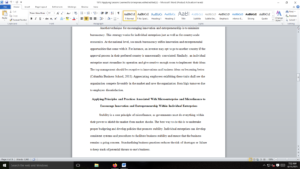Economic development
Much of the focus of this class has been on how countries, institutions, entrepreneurs, and others can systematically encourage innovation and entrepreneurship, and how these can be leveraged into sustainable economic gains. Write a paper that takes the lessons learned from this research and analysis and applies it to individual enterprises. Be certain to answer the following questions:
- What techniques associated with encouraging innovation and entrepreneurship at a country scale can be successfully applied to individual enterprises?
- How can the principles and practices associated with microenterprise and microfinance be applied to encourage innovation and entrepreneurship within individual enterprises?
- How must these techniques be adapted to fit in the enterprise context?
- What are the unique challenges associated with encouraging innovation and entrepreneurship at the enterprise scale vs. the country scale?
- What institutional mechanisms can be put in place by governments and other entities that can help encourage innovation and entrepreneurship?
Wherever possible, apply your answers to your specific organization context and use examples from your own experience to support your views. Be sure to reference any case studies that you may have come across that illustrate how these techniques have been applied successfully to individual enterprises
Requirements: 6 pages
Required Resources
Articles
Diniz, F., & H. Vale Leitao. (2016). Entrepreneurship and social innovation in training and human capital development: The case of the Bank Palmas. Ekonomika Regiona, 12(3), 865-874.
- The full-text version of this book is available through the Directory of Open Access Journals database in the University of Arizona Global Campus Library.
Huggins, R., & Thompson, P. (2015). Entrepreneurship, innovation and regional growth: A network theory. Small Business Economics, 45(1), 103-128. https://doi.org/10.1007/
- The full-text version of this book is available through the JSTOR database in the University of Arizona Global Campus Library.
Paweta, E., & Kirillov, Y. (2016). Analysis of determinants of early-stage entrepreneurial activity In Russia. Comparative Economic Research, 19(1), 65-76.
- The full-text version of this book is available through the Directory of Open Access Journals database in the University of Arizona Global Campus Library.
Su, J., Zhai, Q., & Landström, H. (2015). Entrepreneurship research in China: Internationalization or contextualization? Entrepreneurship & Regional Development, 27(1-2), 50-79. https://doi.org/10.1080/
- The full-text version of this book is available through the EconLit database in the University of Arizona Global Campus Library.
Multimedia
Columbia Business School. (2011, December 9). The next convergence: The future of economic growth in a multispeed world (Links to an external site.). YouTube.
Answer previewRegular audits of the individual enterprise are vital in helping the organization alter its entrepreneurial strategy or even determine the feasibility of incorporating innovation into its operations. Money is a key component in business and since it is a scarce resource, timing its utilization is vital to maximizing all the advantages it yields (Su, Zhai, & Landström, 2015). Undertaking the right move at the wrong time could leave an entity struggling with its obligations and failing to make the improvements it sought initially. After auditing the organization’s status, proper planning is essential in keeping things as smooth as possible, even as the organization implements changes to its strategy.
[1960 Words]

Economic development

